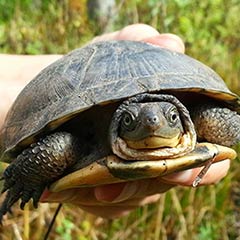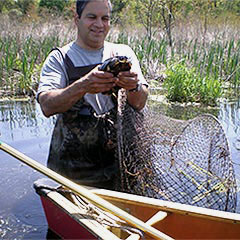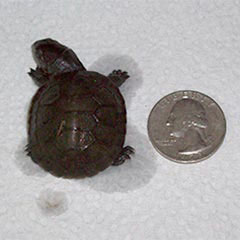
Blanding's turtles
Blanding's Turtles
The Blanding’s turtle, Emydoidea blandingii, ranks near the top of the most threatened wildlife species in the northeastern United States. It's possible that fewer than 3,000 individuals of this relatively large and gentle freshwater turtle species remain in Massachusetts, New Hampshire, Maine, New York and Pennsylvania combined. In Massachusetts, where most of the northeastern Blanding’s turtles live, only four populations are currently known to have 50 or more adult turtles.
Zoo New England’s Field Conservation Department, in collaboration with the Massachusetts Division of Fisheries and Wildlife, the US Fish and Wildlife Service, and a number of local agencies and organizations, is monitoring and helping to protect four different Blanding’s turtle populations around the state. Working with local volunteers and our project partners, we radio-track turtles, protect their nests, and, where possible, restore or enhance critical wetland and nesting habitat. To directly aid in the recovery of declining Blanding’s turtle populations, we and our partners work with about 40 Massachusetts schools each year to raise (“headstart”) hatchling turtles for nine months, and then release them back into their native habitats. We've demonstrated that our headstarted juveniles survive and thrive after their release. Through our Blanding’s turtle headstarting projects, we recruit over 3,000 Massachusetts school children each year to get outdoors and directly help in the recovery of one of our Commonwealth’s rarest wild animals.

 Blanding’s turtles (
Blanding’s turtles (

